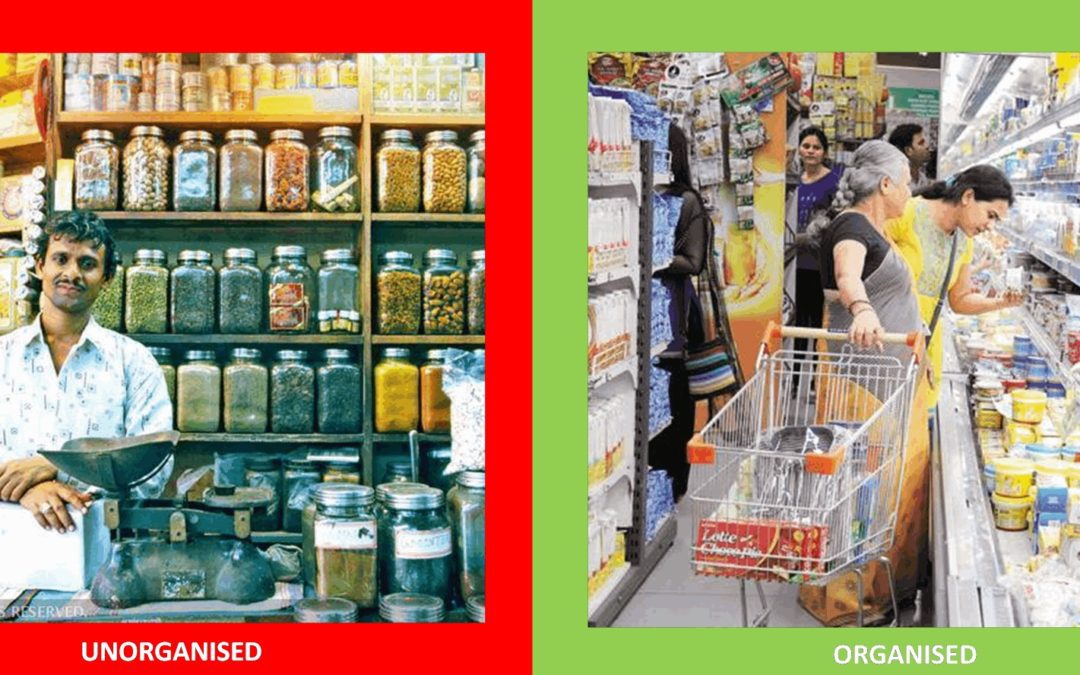Today, the retail industry in India is estimated to be over INR 40 Lakh Crores and accounts to 10% of India’s GDP. According to rough estimates, the unorganised retail sector constitutes over 90% of the country’s retail industry.
The unorganised retail market is the most dominant and popular mode of retailing and purchase destination for the majority of India’s 1.3 billion population. It forms the base or the foundation stone of the retail industry in India and is a deeply rooted and strongly held market mechanism which has stayed for over a century now and continues to rule the country’s retail industry.
The unorganized retail sector primarily comprises of the small scale retail stores, with little or no standardisation, selling goods and services (ideally in fragmented quantities) to the local customers within a small geographical area or locality. There is hardly any use of technology or adherence to processes.
But why or what makes the retail sector unorganized in India.
Limited size of market and scale of operations
The unorganised retail space operates within a small geographical area or locality. The size of the market which it caters to is limited. This restricts the growth of the retail stores and confines them to the small scale. With stagnation, these stores cannot think of incorporating modern management tools and practices, improve their finances and come to the forefront. Also because of high fragmentation in the unorganised retail sector, these stores remain as shadow players in the larger picture.
Lack of standardisation, technology and process
The stores which fall under the unorganised retail sector mostly run on conventions, suitability and convenience. Absence of standardisation and process in retail, adversely impacts the quality and productivity of the retail management. The habits, practices and customs followed every day in those stores forms the processes and standards to be adhered to. But the size and scale of operations are so limited in these stores that unless they expand, there’s hardly any room to introduce standardisation, processes or technology in their operations.
Lack of capital
High cost of capital and difficulties in accessing capital funding has significantly deterred the growth and upgradation of retail businesses, especially in the rural and remote areas.
Most of the unorganised retail market in India comprises of the Kirana stores, the general stores, the corner stores etc. These stores entail low investment and less expertise and do not require any sophisticated infrastructure and merchandising. The low capital requirement eases the reliance on external capital which attracts people for small scale retail trading.
If these small scale retail stores are to be upgraded, retailers will have to hire or build better infrastructure, buy the technology and implement processes in its various functions like supply chain, vendor management, accounts and billing, merchandising etc., for which they are going to need sufficient capital and access to credit from financial institutions.
Unwillingness to take business risks
Are the retailers in the unorganised retail space willing to take the risk of business advancement and expansion? Most of them often tend to play safe. But then this decision is also affected by other factors like the availability of capital and manpower, profits or surpluses, knowledge and training and so on. And if these retailers do not take the business risks, there is no way their businesses can grow and when the businesses do not aim to grow it cannot create a brand, bring in modern practices and technologies, access newer markets, and establish itself as a competent player in the organized retail sector.
Lack of knowledge and training
Lack of adequate knowledge and training in retail management continues to confine the vision and business acumen of retailers in the unorganised space. Without the knowledge, awareness and training, these retailers remain oblivious to the avenues and opportunities available to them which they could use in the advancement of their retail stores.
Deeply rooted and status quo
The unorganised retail market mechanism is deeply rooted and has been in existence ever since retail trading started in India. The retail stores and the distribution network involved in the unorganised retail space provide employment and livelihood to lakhs of stakeholders engaged in it. More than profitability, it offers a source of livelihood for the small scale retailers, store helpers and their families.
The numbers may be fragmented but collectively, across the country, a substantial amount of capital stands invested in these stores, in the distribution network and in inventory.
Lack of retail inclusiveness
Just like financial inclusiveness, there is a need to bring all retail stores under one umbrella. In the absence of retail inclusiveness, it is difficult to gather data on the functioning and operations of the small scale retail stores in the unorganised space to assess the practical difficulties and problems faced by the retailers. Under a common retail inclusion program, retail development training and financial and advisory assistance could be provided to the retailers.
The factors cited above do not act in isolation but overlaps one another in explaining why the majority of the retail sector in India is tilted towards the unorganised side. The unorganised retail market mechanism was not created overnight. It has evolved over decades of market-determined adjustments and corrections to stand where it is today. But if the productivity of the retail industry is to be improved, there is a need to uplift the unorganised retail sector by infusing more capital, modern retail management tools and practices, processes, technology and training.
To know more about “How to become an Organised Retailer?” get in touch with our Retail Experts on [email protected]
YRC Related Articles: How to Write SOPs for Marketing?, 6 Ways To Grow Your Business, How to Start a Retail Business in India, Business Expansion Plan for Small Entrepreneurs, Six Steps to Writing a Great SOP for Retail, How to write SOPs for an Apparel Brand?, How to Develop SOPs for Quick Service Restaurant?, How to write SOPs for Furniture Showroom
Author Bio

Nikhil Agarwal
Chief Operations Officer










